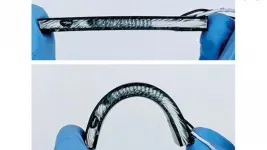Reduced heat leakage improves wearable health device
2021-03-08
(Press-News.org) North Carolina State University engineers continue to improve the efficiency of a flexible device worn on the wrist that harvests heat energy from the human body to monitor health.
In a paper published in npj Flexible Electronics, the NC State researchers report significant enhancements in preventing heat leakage in the flexible body heat harvester they first reported in 2017 and updated in 2020. The harvesters use heat energy from the human body to power wearable technologies - think of smart watches that measure your heart rate, blood oxygen, glucose and other health parameters - that never need to have their batteries recharged. The technology relies on the same principles governing rigid thermoelectric harvesters that convert heat to electrical energy.
Flexible harvesters that conform to the human body are highly desired for use with wearable technologies. Mehmet Ozturk, an NC State professor of electrical and computer engineering and the corresponding author of the paper, mentioned superior skin contact with flexible devices, as well as the ergonomic and comfort considerations to the device wearer, as the core reasons behind building flexible thermoelectric generators, or TEGs.
The performance and efficiency of flexible harvesters, however, historically trail well behind rigid devices, which have been superior in their ability to convert body heat into usable energy.
The NC State proof-of-concept TEG originally reported in 2017 employed semiconductor elements that were connected electrically in series using liquid-metal interconnects made of EGaIn - a non-toxic alloy of gallium and indium. EGaIn provided both metal-like electrical conductivity and stretchability. The entire device was embedded in a stretchable silicone elastomer.
The upgraded device reported in 2020 employed the same architecture but significantly improved the thermal engineering of the previous version, while increasing the density of the semiconductor elements responsible for converting heat into electricity. One of the improvements was a high thermal conductivity silicone elastomer - essentially a type of rubber - that encapsulated the EGaIn interconnects.
The newest iteration adds aerogel flakes to the silicone elastomer to reduce the elastomer's thermal conductivity. Experimental results showed that this innovation reduced the heat leakage through the elastomer by half.
"The addition of aerogel stops the heat from leaking between the device's thermoelectric 'legs,'" Ozturk said. "The higher the heat leakage, the lower the temperature that develops across the device, which translates to lower output power.
"The flexible device reported in this paper is performing an order of magnitude better than the device we reported in 2017 and continues to approach the performance of rigid devices," Ozturk added.
Ozturk said that one of the strengths of the NC State-patented technology is that it employs the very same semiconductor elements used in rigid devices perfected after decades of research. The approach also provides a low-cost opportunity to existing rigid thermoelectric module manufacturers to enter the flexible thermoelectric market.
He added that his lab will continue to focus on improving the efficiency of these flexible devices.
INFORMATION:
NC State colleagues Viswanath P. Ramesh, Yasaman Sargolzaeiaval, Taylor V. Neumann, Veena Misra, Michael Dickey and Daryoosh Vashaee co-authored the paper.
Funding for the work comes from the NC State's National Science Foundation-funded Advanced Self-Powered Systems of Integrated Sensors and Technologies (ASSIST) Center under grant EEC1160483. The mission of the ASSIST Center is to create self-powered wearables capable of long-term multi-modal sensing without having to replace or charge the batteries.
- kulikowski -
Additional Contact: Mick Kulikowski, News Services, 919/218-5937 or mjkuliko@ncsu.edu
Note to editors: An abstract of the paper follows.
"Flexible Thermoelectric Generator with Liquid Metal Interconnects and Low Thermal Conductivity Silicone Filler"
Authors: Viswanath P. Ramesh, Yasaman Sargolzaeiaval, Taylor V. Neumann, Veena Misra, Daryoosh Vashaee, Michael D. Dickey and Mehmet C. Ozturk, North Carolina State University
Published: March 8, 2021, online in npj Flexible Electronics
DOI: 10.1038/s41528-021-00101-3
Abstract: Harvesting body heat using thermoelectricity provides a promising path to realizing self-powered, wearable electronics that can achieve continuous, long-term, uninterrupted health monitoring. This paper reports a flexible thermoelectric generator (TEG) that provides best-in-class performance in converting body heat to electrical energy. The device relies on a low thermal conductivity aerogel-silicone composite that secures and thermally isolates the individual semiconductor elements that are connected in series using stretchable eutectic gallium-indium (EGaIn) liquid metal interconnects. The composite consists of aerogel particulates mixed into polydimethylsiloxane (PDMS) providing as much as 50% reduction in the thermal conductivity of the silicone elastomer. Worn on the wrist, the flexible TEGs present output power density figures approaching 35μWcm-2 at an air velocity of 1.2 ms-1, equivalent to walking speed. The results suggest that these flexible TEGs can serve as the main energy source for low-power wearable electronics.
[Attachments] See images for this press release:

ELSE PRESS RELEASES FROM THIS DATE:
2021-03-08
Rome, Italy, March 8, 2021 - Allelica, a leading genomics software company specialising in developing polygenic risk scores (PRS) for personalised medicine, today announced publication of a study in Circulation (Vol. 143, Issue 10) showing that the effect of LDL cholesterol on a person's risk of having a heart attack depends on their genes. Using Allelica's proprietary PRS analysis software, the data showed that combining information on an individual's genetic risk of heart attack with their LDL level helps determine those at most risk from heart attack, including those potentially in need of treatment with statins or PCSK9 inhibitors. The PRS was also able to identify individuals eligible for therapeutic intervention based on current ...
2021-03-08
To avoid a substantial increase in water scarcity, biomass plantations for energy production need sustainable water management, a new study shows. Bioenergy is frequently considered one of the options to reduce greenhouse gases for achieving the Paris climate goals, especially if combined with capturing the CO2 from biomass power plants and storing it underground. Yet growing large-scale bioenergy plantations worldwide does not just require land, but also considerable amounts of freshwater for irrigation - which can be at odds with respecting Earth's ...
2021-03-08
Diphtheria - a relatively easily-preventable infection - is evolving to become resistant to a number of classes of antibiotics and in future could lead to vaccine escape, warn an international team of researchers from the UK and India.
The researchers, led by scientists at the University of Cambridge, say that the impact of COVID-19 on diphtheria vaccination schedules, coupled with a rise in the number of infections, risk the disease once more becoming a major global threat.
Diphtheria is a highly contagious infection that can affect the nose and throat, and sometimes the skin. If left untreated it can prove fatal. In the UK and other high-income countries, babies are vaccinated against ...
2021-03-08
DALLAS, March 8, 2021 -- Out-of-hospital cardiac arrests triggered by opioid overdose are a significant cause of death among adults 25 to 64, according to a scientific statement from the American Heart Association, the nation's largest voluntary health organization focused on heart and brain health for all. The statement published today in the Association's flagship journal Circulation.
In the U.S., opioid use disorder affects an estimated 2 million people each year and costs more than $78 billion in health care expenses. The opioid epidemic, ...
2021-03-08
DALLAS, March 8, 2021 - While most people think of strokes affecting the brain, they can also affect the eye. Central retinal artery occlusion (CRAO) is a rare form of acute ischemic stroke that occurs when blood flow is blocked to the main artery of the eye. It typically causes painless, immediate vision loss in the impacted eye, with fewer than 20% of people regaining functional vision in that eye.
Today, the American Heart Association published a new scientific statement, "Management of Central Retinal Artery Occlusion," in Stroke, an American Heart Association ...
2021-03-08
The analysis of immune cells infiltrating cerebrospinal fluid enables the characterization of the tumor microenvironment in brain metastases.
Findings reported today in Nature Communications* confirm that these cells recapitulate the characteristics of those detected in brain metastases, and could act as novel and non-invasive biomarkers to predict patient responsiveness to immune-based therapies.
Results from a study led by Joan Seoane, Director of Preclinical and Translational Research co-program at VHIO and ICREA Professor, show that immune cells accessing cerebrospinal fluid faithfully recapitulate the characteristics of cells identified in brain metastasis, and could therefore constitute novel ...
2021-03-08
Philadelphia, March 8, 2021 - Virtual reality avatar-based coaching shows promise to increase access to and extend the reach of nutrition education programs to children at risk for obesity, according to a new study in the Journal of Nutrition Education and Behavior, published by Elsevier.
Researchers introduced 15 adult-child dyads to a virtual avatar-based coaching program that incorporated age-specific information on growth; physical, social, and emotional development; healthy lifestyles; common nutrition concerns; and interview questions around eating behaviors and food resources and counseling.
"We developed a virtual reality avatar computer program ...
2021-03-08
For the drug approval process in the United States, investigators have been expanding clinical trials to sites outside the country. However, a new study indicates that this trend may be widening racial disparities in patient enrollment in cancer clinical trials. The study is published by Wiley early online in END ...
2021-03-08
An independent analysis of the medical trials which formed the final basis of approval by the US Food and Drug Administration (FDA) strongly suggests the drug bremelanotide has very limited effectiveness as a treatment for hypoactive sexual desire disorder (HSDD) in women, and that trial participants preferred a placebo.
The analysis, published today in the peer-reviewed Journal of Sex Research, also highlights issues with the validity of HSDD as a diagnosis. The condition was removed from the American Diagnostic and Statistical Manual of Mental Disorders (DSM-5) in 2013.
Professor Glen Spielmans, of Metropolitan State University, USA, examined data from bremelanotide's FDA New Drug Application, ...
2021-03-08
Suicide is the second leading cause of death among youth aged 5 to 21 years in the United States. Between 2010 and 2019, suicide rates among this group increased 40%.
Youth involved in the child welfare system experience an even greater risk of suicidal behavior, yet research on this vulnerable population is minimal.
To better understand and prevent suicide in this at-risk group, researchers at Nationwide Children's Hospital conducted the first study to compare characteristics and health service utilization patterns of youth suicide decedents (those ...
LAST 30 PRESS RELEASES:
[Press-News.org] Reduced heat leakage improves wearable health device

